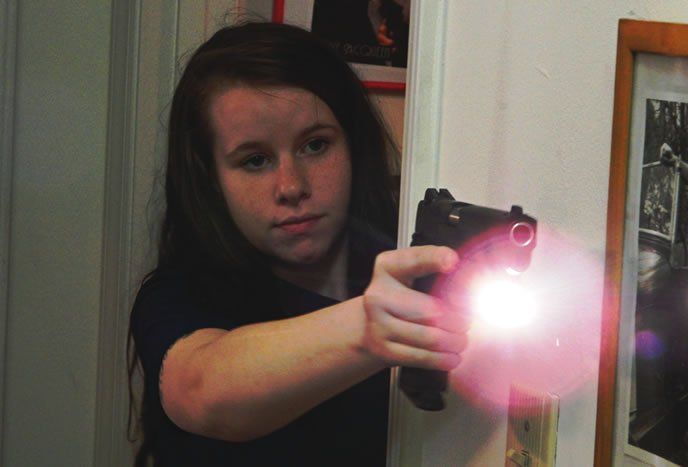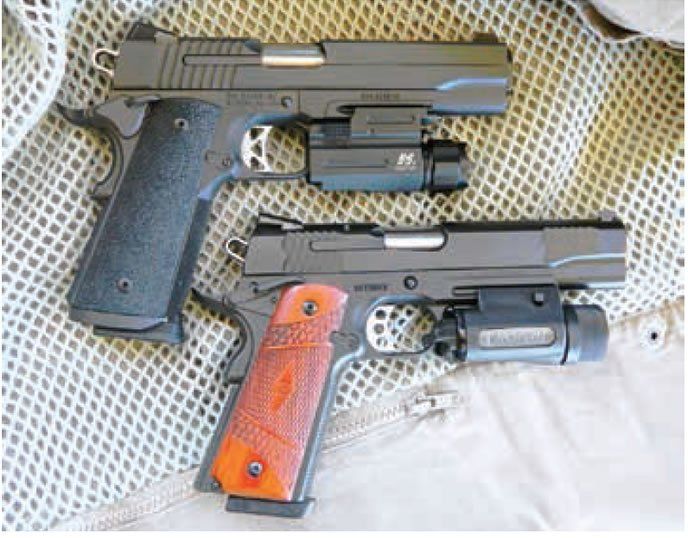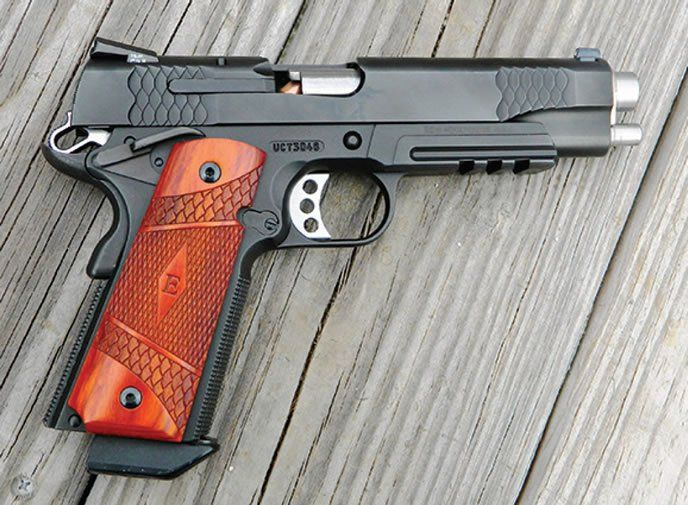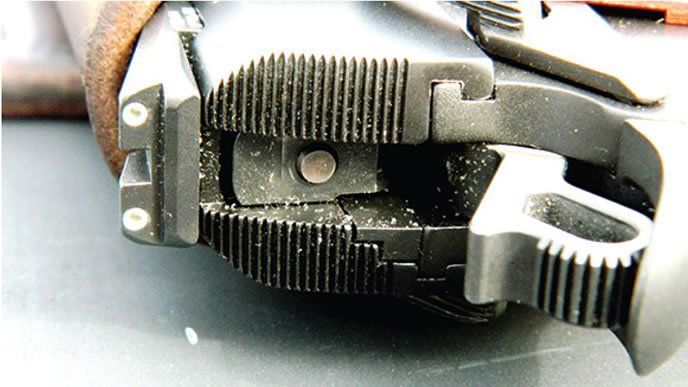Gun Tests has been independently reviewing firearms since 1989. This website contains many older reviews. Unless otherwise noted, these reviews carry the guns’ prices at the time of the original review.
The 1911 handgun has survived for more than one hundred years based on excellent ergonomics, great reliability, and its ability to chamber a fight-stopping cartridge. Modern 1911 handguns are much evolved from the Colt 1911 first issued to Army troops in 1911. However, a doughboy going to Europe in 1917 would be able to instantly load, make safe, fire and use a modern 1911 handgun. The ability of the platform to accept a weapon-mounted light was an inevitable part of the 1911’s evolution, because a gun-mounted combat light is a good tactical addition. They allow for the identification of a threat, illumination of an area, and make fail-safe identification possible.

Two so-equipped full-size 1911s are the SIG TACOPS and the Smith & Wesson 1911TA E Class. The SIG Sauer 1911 TACOPS 1911R-45TACOPS, $1213 list, is a no-nonsense black tactical pistol. We found it at DefenderOutdoors.com for $1,080, at BudsGunShop.com for a cash discount price of $1,062, and for $910 at GrabAGun.com. Our test gun is part of the larger SIG 1911 family, which at our last count, had 31 members. Generally speaking, SIG 1911s have done very well in our evaluations. In the October 2014 issue, we graded a 1911 Carry Scorpion 1911CAR-45-SCPN as a B+. In the November 2013 issue, a 1911 Carry Stainless 1911CA-45-SSS earned an A- grade and a “Best Buy” nod. In the February 2009 issue, a 1911 C3 No. 19GS0031 earned an A grade. In the May 2006 issue, a Sigarms 1911 GSR No. 19GS0001 earned a Conditional Buy, mainly because of its price, not its functionality. We’d translate that to a B+ today.

S&W’s SW1911 “E” Series pistols are supposed to be “enhanced, with tight tolerances, precision-fit trigger, chamfered and recessed muzzle, “fish-scale” scalloped slide serrations and other premium features commonly found on custom-made firearms. The standard E-series 1911s come in blued or stainless steel, and the model number with “SC” appended have scandium-alloy frames. The blued version we tested is #108409, while the stainless model is #108411. List for our test gun is $1399, and we saw it for sale at DefenderOutdoors.com for $1140, TombstoneTactical.com for $1099, and at BudsGunShop.com for $1065.
Smith 1911s have not matched SIG’s level of performance in our tests. In the April 2010 issue, the S&W Model SW1911 No. 178017 in 9mm got a B+. A 45 ACP Smith & Wesson MSW1911 No. 108284 earned a B+ in the February 2010 issue. In March 2006, a 1911SC No. 108289 got a “Don’t Buy” rating, as did a 1911PD No. 108296 tested in the November 2005. Way back in April 2003, we tested the first-year version of the company’s 1911 and said “Buy It” to a Smith & Wesson 1911 45 ACP.
But history isn’t necessarily destiny at Gun Tests. Out of the box, the Smith & Wesson had more bling and eye appeal, no denying that. And at the heart of each pistol was a tight barrel-to-slide fit, which provided X-ring accuracy without sacrificing reliability. Just like you, we prefer to shoot good guns, and what we found here were two pretty good ones, though our team had its preference at the end.
SIG Sauer 1911 TACOPS 1911R-45TACOPS 45 ACP, $1213
The SIG TACOPS is the latest in SIG’s development of the 1911. The Granite Series Rail gun was the original pistol, and it was the primogenitor of quite a few SIG-made 1911 handguns. SIG introduced a 1911 without a light rail to complement the GSR, compact versions, and the latest TACOPS pistol. The primary difference in appearance between this handgun and other 1911 handguns is the slide configuration. The slide is subtly different in appearance to preserve a resemblance to the highly successful SIG P-series pistols, such as the P220, P226, P229 and others. The resemblance is there, and some do not care for it. The primary consideration in purchasing the SIG is to be certain that the holsters you wish to use are available for the SIG 1911 slide design. Some leather holsters will accept the SIG when they are cut for the standard slide, and over time they will morph to fit the SIG. Others, well, no way and no how. Then there is the added complication of holstering a 1911 with a rail, and this applies to all guns with rails, which we’ll call “rail guns” for short hereafter. Just be aware of the searching you may have to do to fit the SIG to a quality holster. Every holster maker does not have the mold.
The SIG features an external extractor. While the P-series extractors are trouble free, the 1911 is a different design of the same type. It worked just fine in our tests of the TACOPS and similar SIG handguns. The hammer is a skeletonized design. The sights are Novak low-mount units. These sights are never a bad choice for a fighting pistol, in our estimation. The Novak sights feature self-luminous tritium inserts in a three-dot arrangement.
There are slide serrations only at the rear and no forward cocking serrations. While some prefer that the forward serrations be deleted, for gloved-hand use and for the greatest leverage in clearing a stuck cartridge, the forward cocking serrations are a good bet. This was a demerit to the SIG because the Smith & Wesson does have forward cocking serrations.
The SIG features a positive firing-pin block. This drop safety keeps the firing pin from hitting the primer until the trigger is pressed completely to the rear. This device adds parts to the gun, and some feel that it adversely affects the trigger action. Here, the trigger action was smooth and crisp at 6.25 pounds and was a superior factory trigger, we felt. The trigger was a skeletonized version, unlike the solid triggers seen in most SIG advertisements.
The grip safeties were remarkably alike. In this day and time, they may come from the same vendor. The SIG grip safety was well shaped and gave good control, properly releasing the trigger about halfway into compression of the grip safety. Some of us like to use the thumbs-forward shooting grip, and this tends to lift the palm of the firing hand off the grip safety. The SIG grip safety gets high marks for fit and comfort and accommodating the high-thumbs grip. The ambidextrous slide safety likewise gets high marks. It was large enough for good control and indented sharply. The right-hand control was slightly smaller than the left hand’s. On either side it was unobtrusive and a good design.
The grips were made by Ergo, available as an aftermarket item and previously tested at Gun Tests. They were good examples of tactical grips, offering good adhesion but not enough abrasion to be uncomfortable. The backstrap was serrated, and the frontstrap was nicely checkered at 25 lines per square inch. Underneath the grip frame was a conservative magazine well similar to the Wilson Combat Mag Guide.

The Nitron finish is a form of ferritic nitrocarburizing that is similar to case hardening. This finish diffuses nitrogen and carbon into the steel to add scuff resistance and resist corrosion. The finish was evenly applied and appeared businesslike, as well as being nonreflective. Compared to the Melonite finish of the Smith & Wesson, the SIG finish is duller. If you like the nonreflective black-tactical look, you will like the Nitron finish.
At the firing range, the SIG came out of the box running, with no failures to feed, chamber, fire, or eject during the test program. The initial firing was done on the combat course with inexpensive Black Hills “Blue Box” 230-grain FMJ for familiarization. We also used modest-power handloads. A combination of a good trigger and excellent sights gave good results in fast-paced combat drills. The pistol was clearly an excellent performer as a defensive pistol.
On the line firing from a solid benchrest firing position, the SIG also proved accurate, and in this price range and with superior barrel fitting it should be. The single best group from the SIG TACOPS was fired with the Fiocchi 230-grain Extrema, which measured 2.0 inches. We were happy with that, but the Smith & Wesson outpaced the SIG by a margin. All in, the SIG TACOPS made a good showing with ball ammunition, a defensive JHP load, and also a +P defensive loading.
While shooting the SIG, we found it was easier to quickly load due to the extended slide lock. This slide lock doesn’t put much of the steel where the support hand may contact the slide lock during firing and inadvertently lock the slide open during a firing string. This is a common complaint with 1911 handguns, but it never happened with this SIG. Coupled with the modest magazine-well guide, the ability of the shooter to keep the pistol in action was excellent. As a side note, we should credit the D&L Sports quad-magazine carrier for keeping the SIG and S&W chugging along smartly.
A consideration: While mounting lights on the handguns to check for fit, we encountered a bobble. The lights fit all guns in the house, including Glock, SIG Scorpion, SIG P250, SIG P226 MK25, CZ 75, and the Smith & Wesson SW1911TA. After mounting an Insight illuminator on the TACOPS, we had a difficult time getting the light off the rail. Members of our team had to use a brass punch and hammer to carefully pry the foot off the TACOPS rail.
Our Team Said: When the final notes were studied and the individual scores tabulated, the SIG Sauer TACOPS had to receive an A rating. Accuracy, reliability and handling were faultless. However, the Smith & Wesson outpaced the SIG on features, and all of them are not just bling. The SIG also has advantages, including the fact that it is supplied with a total of four magazines versus the Smith & Wesson’s two magazines. This was a close race, but our shooters rated the SW1911TA the better buy.
Smith & Wesson SW1911TA E-Series No. 108409 45 ACP, $1399
The E-class Smith & Wesson is the latest development of the SW1911 series and is a revamping of the line in many ways. The pistol remains a traditional 1911 in appearance, and holsters for the Colt or Taurus rail guns will also fit the SW1911TA. This is an advantage, we felt. The pistol’s Melonite finish is comparable to the Nitron-finished SIG, although brighter than the SIG. The Novak sights with tritium inserts were identical. The beavertail grip safety of the SW1911TA was very similar to the SIG.

Also like the SIG, the Smith & Wesson features an external extractor. Engineers like to point out that coils are more reliable than leaf springs, and that reliability and repeatability are superior with this design. Whatever your preference, external extractors seem to be the wave of the future in the tactical 1911. This extractor is larger than some other designs, taking a bigger bite on the extractor groove.
The fit, feel, and finish quality of the SW1911 were similar to the SIG. The grip safety and the Novak sights are similar. The lightened trigger of the SW1911TA is a different design than the SIG, but it seems to accomplish the same thing. Trigger compression of the Smith & Wesson pistol felt similar to the SIG — both are smooth with little creep and no discernible backlash. However, an average of three trigger compressions showed the SW1911TA at 5.75 pounds was lighter than the SIG. We would have liked a 5-pound trigger on either gun, but the action was acceptable.
The SW1911TA does not have a beveled magazine well, the only thing the SIG has the SW1911TA does not, other than the firing pin block. The Smith & Wesson does not use the Swartz-style grip-safety-activated firing-pin block used by previous Smith & Wesson 1911 handguns. The SW1911TA utilizes a titanium firing pin and heavy-duty firing pin spring to ensure safety if the pistol is dropped on the muzzle. If you prefer a pistol without the drop safety, the SW1911TA is the one to pick. If you intend to add an aftermarket trigger set with a lighter competition-grade trigger, then this pistol offers less complication.
However, there are significant differences in how the pistols are appointed. The Smith & Wesson retails for one hundred dollars more than the SIG, but we feel that the Smith & Wesson offers more features than the small difference in price would imply. As one example, the SW1911’s ambidextrous safety features an upswept component on either side, making it friendlier for left-hand use. Also, the safety intended for left-hander use is supported by the grip panel. We rated this design superior to the SIG’s.
Some of the features of the SW1911TA are downright byzantine they are so nice, but in some handguns the effects dissipate when firing the pistol. This was not true with the SW1911TA.

The SW1911TA features a serrated or ribbed section in the top of the slide that runs from the front to the rear sight. One of the raters noted that this rib is very similar to that found on high-grade Smith & Wesson revolvers. If the SIG 1911 is made to appeal to P-series fans, the SW1911TA appeals to Smith & Wesson fans of all stripes, including revolver fans. This serration would be horribly expensive as a custom option. If you look at the rear sight, the rear face and the rear of the slide are each serrated. This is a very nice touch.

The front of the slide also received some attention. The muzzle is nicely crowned and chamfered. This reduces the chance of damaging the barrel crown. The slide also features forward cocking serrations. These are the same fish scale or serpentine pattern as the rear cocking serrations. This is a tactically superior addition to the pistol, in our view. Generally, the forward cocking serration has a reputation for being abrasive and even destructive to leather holsters. The Smith & Wesson SW1911TA design manages to angle the cocking serrations so they do not abrade the holster.
The new SW1911TA extractor design is a heavier piece than the one used in the past, and it seems an improvement. The ejection port is slightly larger than most lowered types, and works well. The frame of the SW1911TA features a dished out portion under the trigger guard. This makes for greater comfort in firing and slightly raises the muzzle when the proper hold is used, resulting in a lower bore axis. When we fired the pistol in rapid-fire drills, the Smith & Wesson seemed to sit lower in the hand. This was subjective to some, but, objectively, the cut-out in the frame must work. We rated this an advantage over the SIG.

The grips are excellent, giving good adhesion and comfort. They are laminated wood and were more attractive than the SIG TACOPS grips, we thought. With the same Fiocchi 230-grain Extrema load, the SIG was less accurate than the SW1911TA, with the average at 2.0 inches for five shots. This is still excellent by most standards. Overall, however, average accuracy for the SW1911TA was better than the SIG.
On the downside, while initially firing both Black Hills FMJ and a handload using the Montana Gold 185-grain JHP at 900 fps, the SW1911TA suffered a single failure to feed with the handload, in the first magazine fired. We rated this as a break-in malfunction because the malfunction did not repeat itself. Also, these handloads are lighter than most factory loads. The malfunction did not appear to be magazine or shooter related.

Another note: The standard side slide lock of the SW1911TA was nicely checkered on the top, but it was not as quick in manipulation as the SIG, our shooters said. Some do not realize that the nice beavertail safety we all like for shooting comfort also slightly moves the palm outward, and it is possible to make manipulation of the slide lock more difficult. However, if the piece is used hard, our experience indicates the extended slide lock is more prone to a malfunction and is also more prone to snagging on leather holsters. If it is a problem, an extended slide lock may be added for around $50. We would not change the Smith & Wesson’s.
Our Team Said: The SW1911TA is a pistol that keeps pace with both its competitors and customer expectations. The Smith & Wesson was more accurate in benchrest shooting, and it gave better results in addressing steel plates and other rapid-fire drills. We ran the pistols over a virtual Gymkhana on the range, and the SW1911TA was the superior in this regard. Though the SIG is a top-flight pistol, the SW1911TA made even challenging courses seem mediocre. We would pick the Smith & Wesson SW1911TA E-Series No. 108409 over the SIG TACOPS.
Written and photographed by R.K. Campbell, using evaluations from Gun Tests team testers.
























